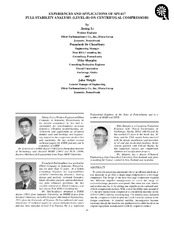| dc.contributor.other | Turbomachinery Symposium (34th : 2005) | |
| dc.creator | Li, Jiming | |
| dc.creator | De Choudhury, Pranabesh | |
| dc.creator | Sharples, Mike | |
| dc.creator | Wright, John | |
| dc.date.accessioned | 2017-10-04T23:01:11Z | |
| dc.date.available | 2017-10-04T23:01:11Z | |
| dc.date.issued | 2005 | |
| dc.identifier.uri | https://hdl.handle.net/1969.1/163237 | |
| dc.description | Lecture | en |
| dc.description | Pg. 35-44 | en |
| dc.description.abstract | To cover the remaining operation life of an offshore platform, it was necessary to go from a single stage compressor to a two-stage compressor. The design of the new two-stage compressor required two different impeller arrangements to cover the range of suction/discharge pressures anticipated. One rotor has nine wheels and another one has 11 by adding one impeller at the outboard ends of both compression sections. With a rotor flexibility ratio around of 2.5, the new replacement compressor is a borderline machine on the API 617 (2002) stability screening map. The stability study indicated that the compressor failed to meet the Level-I stability criteria at the design conditions. A detailed stability investigation became necessary though the machine was predicted to be stable based on an original equipment manufacturer's (OEM) empirical method. An independent party was contracted to conduct a full stability audit on both rotors. Compressor cross-coupling was evaluated uniquely and lumped at each impeller location in the analysis model. Additionally, the destabilizing force from all labyrinth seals in the compressor were calculated and included in the detailed stability analysis. The study results indicated that both rotors would most likely be susceptible to severe instability problems even using a modified center labyrinth seal with a shunt-injection and swirl brakes. Consequently, the effect of damper seals on the rotor stability was further investigated independently. It was concluded that a honeycomb seal could bring the log-decrement to a distinctively positive value for the nine-wheel rotor, but not succeed in raising the log-decrement to positive for the 11-wheel rotor. Because of faster than anticipated declines in well deliverability, it was decided to bypass the nine-wheel configuration and install the 11-wheel configuration. The 11-wheel rotor used a modified center labyrinth seal with a shunt/brake deswirl system. As a backup, the nine-wheel rotor and the inner casing were modified to fit with a pocket damper seal. The 11-stage compressor was successfully commissioned and has run well in the field for more than one year. Overall shaft vibration level was low and the predicted subsynchronous vibration was not observed. In this paper, a correlation study was carried out and a comparison was made to discuss how to calculate the Wachel number, and how to practically evaluate the contribution of the labyrinth seals and the gas deswirl devices in a detailed (API Level-II) rotor stability analysis. | en |
| dc.format.medium | Electronic | en |
| dc.format.mimetype | application/pdf | |
| dc.language.iso | en | |
| dc.publisher | Texas A&M University. Turbomachinery Laboratories | |
| dc.relation.ispartof | Proceedings of the 34th Turbomachinery Symposium | en |
| dc.subject.lcsh | Turbomachines | en |
| dc.title | Experiences And Applications Of API 617 Full Stability Analysis (Level-II) On Centrifugal Compressors. | en |
| dc.type.genre | Presentation | en |
| dc.type.material | Text | en |
| dc.identifier.doi | https://doi.org/10.21423/R1B359 | |


